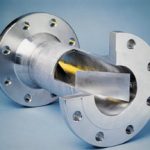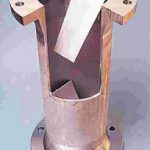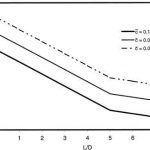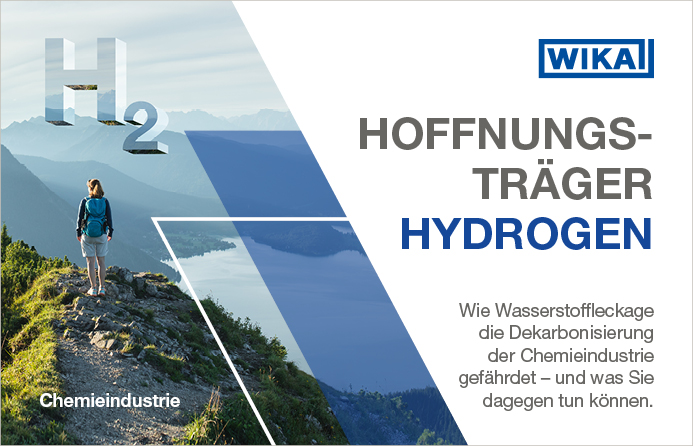The standard KVM mixer has a simple, robust design and a remarkable mixing performance. Providing the fluids to be mixed are fully soluble in any ratio, practically all mixing problems in the turbulent flow regime can be solved using the standard version of the KVM mixer.
Gottlieb Schneider
There is still a widely held view that it is possible to achieve rapid, homogeneous mixing of low-viscosity fluids (gases, liquids) in an empty pipe, providing the flow characteristic is turbulent. For this reason, installing static mixers under such flow conditions is frequently considered to be superfluous, complicated and moreover too expensive. However, experience over the years has shown quite clearly that in the majority of applications in the chemical and petrochemical industries, as well as in refineries and water treatment plants, static mixers offer substantial benefits over and above empty pipe solutions, even when turbulent flow conditions are predominant. The improved results achieved with static mixers apply equally to newly built plants and to retrofits in existing processes. In addition, various publications have confirmed that the process of mixing in the turbulent flow regime is not quite as simple as is often assumed. In practice it can be repeatedly seen that too little regard is paid to the differences that frequently exist between the densities and/or viscosities of the individual media to be mixed. At low flow velocities, for instance with minimum throughput, this can very quickly lead to inadequate mixing results. As a result, there is an increase in the formation of by-products, e.g. in chemical processes, and the level of purification achieved in water treatment plants may be insufficient. Such negative effects can be avoided by installing a suitable, correctly designed static mixer. In water treatment processes, it is moreover possible to achieve rapid, homo-geneous distribution of flocculants and at the same time substantially reduce the dosing amounts without compromising purification efficiency. Cases are known where savings of up to 45% have been brought about.
Principle of the static mixer
The demands of the market regarding static mixers for applications in the turbulent flow regime include:
• Insensitivity to fluctuations in throughput, so that good, constant mixing results are guaranteed at all times,
• a simple, robust design not prone to blockage and easy to install,
• a low pressure drop,
• an attractive price/performance ratio.
The market requirements referred to above were the performance targets set for experts in CFD (Computational Fluid Dynamics) called in to assist the mixing specialists at this company. Within just a few months, a completely new type of static mixer was developed, optimised and tested. The result of this close cooperation is the KVM mixer (Fig. 1) which fulfils the aforementioned demands.
Figure 2 shows the principle of the KVM mixer. The vanes mounted in the flow path, whose geometry and arrangement in the pipe have been optimised, generate two large counter-rotating vortices – hence the term „vortex mixer“. These vortices are propagated over the entire cross-section of the pipe within a short stretch and also completely embrace the wall areas .
Mixing performance
The mixing performance of the standard KVM mixer is remarkable. With a mixing ratio in the range from 1:1 to 1:1000, homo-eneity with a variation coefficient of s/c # 1-5% (corresponding to a degree of mixing $ 95 – 99%) can be achieved – a level of homogeneity that can be regarded as adequate for the majority of applications (Fig.3). This mixing performance applies to Reynolds numbers $ 10,000. In addition, it is important to note that this result is obtained by dosing the additive at a single injection port in the pipe wall. No complex, multipoint dosing is necessary, in other words.
Providing the fluids to be mixed are fully soluble in any ratio, practically all mixing problems in the turbulent flow regime can be solved using the standard version of the KVM mixer. The KVM mixer is not recommended for applications in which fluids have to be dispersed or contacted with gases, and are to a large extent insoluble in one another. For such dispersion and contacting tasks it is preferable to employ the SMV mixer instead. This type of mixer is able to generate the large phase interface necessary for efficient mass transfer economically.
Pressure drop
The pressure drop for the standard version of the KVM mixer amounts to 2.4 times the velocity heads.
The pressure drop for water flowing at a velocity of 1m/s is consequently only 12mbar.
Applications
There are many potential applications in the chemical and petrochemical industries, as well as in refineries, in the areas of low-viscosity, miscible liquids and gases. In these branches of industry, the focus is on pure mixing tasks, e.g. for compensating concentration, temperature or density differences, as well as on general homogenisation of the flow ahead of sample ports.
In water and waste-water treatment processes, small streams of additives such as flocculants, flocculating agents and/or disinfectants have to be evenly distributed in the water stream. In other instances, a water stream needs to be neutralised or brought to a specific pH value by adding an acid or a base.
KVM mixer versions
The KVM mixer has an installed length of about 3.5 pipe diameters. Additives are introduced at a high velocity between 0.5 and 1.0 pipe diameters upstream of the mixer, at a single injection point in the pipe wall. Should it be necessary to measure the pH value or the temperature downstream of the mixer, for example, these measuring points have to be fitted 2 to 3 pipe diameters after the mixer outlet.
Standard mixer versions with nominal diameters of DN 25 or more are available in stainless steel AISI 316L. Above DN 150 they can also be supplied in carbon steel with weld ends or flanges. Upwards of a nominal diameter of DN 400, coated made of carbon steel can be lined with epoxy resin, for instance. They can also be manufactured using other materials, such as Hastelloy, Monel or titanium.
Koch-Glitsch
Fax: ++41/52/2 02 90 53
Further information cpp-257
Symbols
Dp fPag Pressure drop
D fmg Internal pipe diameter
v fm/sg Flow velocity
c f-g Arithmetical mean
r fkg/m3g Density
s f-g Empirical standard deviation
Unsere Whitepaper-Empfehlung
Wasserstoff gilt als Schlüssel für die Dekarbonisierung der Chemieindustrie. Doch die Nutzung des vermeintlichen Hoffnungsträgers Hydrogen birgt auch Gefahren und stellt die Branche vor neue Herausforderungen, die das gratis Whitepaper „H2 wie Hoffnungsträger?“ näher für Sie…
Teilen:















